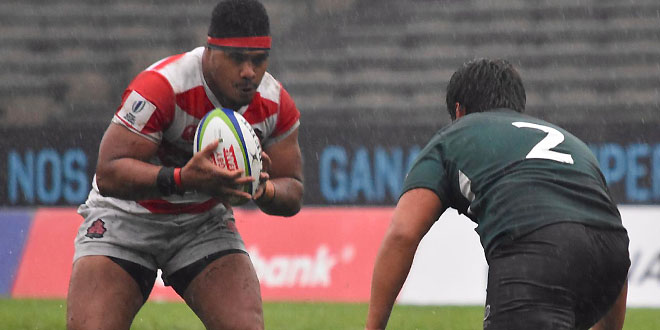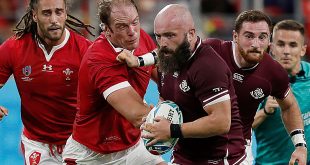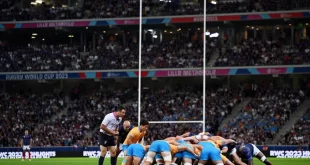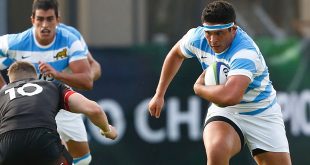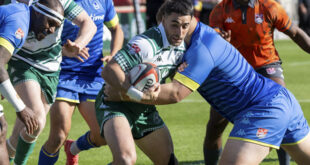We’ve reviewed the footage and after some debate have come to a consensus. A tournament tortured by horrendous weather demanded a tactical approach from the winning teams and left little room for individual expression. Glimpses of that were seen in the second and third rounds, and just enough for us to separate those most deserving.
A number of players who might have come into the tournament with high expectations and may yet find success at senior international level did not earn selection to this side. Part of this can be attributed to the conditions but the players themselves must accept that they under-performed. Canada and Fiji, in particular, had players of real quality who should have been strong contenders but instead were largely absent in final discussions.
Appropriately it’s Japan who have the greatest representation but perhaps surprisingly finalists Portugal only have two players in the side. This can be explained by the fact that they were not a dominant side, rather they did just enough in each of their victories to get the win with defensive commitment from the team playing a large role in their success. Hong Kong are the only side not to have a player selected but do have a couple honorable mentions.
1 – Chang-Ho Ahn (Japan) Short, stocky, and technically astute. The dominant scrummaging loosehead in the tournament won every battle and looks a good prospect for the senior side. Grabbed a brace of tries in an excellent performance against Canada that showed his strength in the tight-loose. Agustín Sosa of Uruguay had a strong tournament, as did Chile’s Piero Zunino.
2 – Hinata Takei (Japan) A difficult choice with a few players in the mix. Uruguay’s Yamandú Arburúas was excellent as was Nuno Mascarenhas of Portugal. Takei takes it by a nose after starting all four matches and captaining the side to victory in the final. His three tries scored are a testament to his work rate and his performance in the set piece was high quality. He’s not the biggest player and with hooker a strength of Japanese rugby the path to test rugby for Takei is not certain.
3 – Guillermo Pujadas (Uruguay) There was no debate required on the right side of the scrum. Outstanding in all facets, his play in the loose was just as impressive as his work in the tight. The only knock against him is his relative lack of size. He’ll need to add a few kilos in body mass to survive test rugby, with a move to loosehead prop also a possibility. Canadian powerhouse Cole Keith highlighted his undoubted potential against Hong Kong but did not start the tournament in the same form.
4 – Ryuga Hashimoto (Japan) Probably the weakest position in the tournament, the size difference between Championship-level locks and those of the second tier is telling. Until teams in the Trophy can find bigger men up front they will not be able to compete against the top dogs of the rugby world. Fijian captain Temo Mayanavanua and Adriaan Ludick of Namibia were the biggest lumps around but didn’t have the work rate of Hashimoto. Standing only 1.88m (6’2″), he is too short for a test lock and will have to switch to blindside or possibly tighthead prop moving forward. At only 18 years old he is robust, however, and was among the best front-on tacklers on display.
5 – Manuel Leindekar (Uruguay) A towering specimen who is already entrenched in the senior Teros team. Perhaps not the most athletic but every team needs a big man and Leindekar is certainly that, and at 115kg (255lbs) still has room to grow. Dominant in the tight-loose and useful as both a jumper and lifter in the lineout. Now back in the Oyonnax academy, he should enjoy a solid professional career.
6 – Faulua Makisi (Japan) Player of the Tournament. A man among boys when it comes to the contact area, no surprise given his hulking physique. Tongan-born but committed to representing Japan, the main mark against him is a lack of height as was the case with Hashimoto. Otherwise he is destructive, dynamic, and deceivingly agile. Has the frame who switch to the front row if the higher-ups determine his test future is elsewhere.
7 – Alfonso Escobar (Chile) The inspirational leader of the junior Cóndores. Courageous in defense and tireless as a support player going forward. There may have been better athletes but the pure desire to win is an underrated attribute, and one that Escobar exudes. For that reason alone he will be in the conversation at senior level sooner than later.
8 – Santiago Civetta (Uruguay) Almost every other player at this position was bigger and more powerful but none had the overall impact of the Teritos standout. Very quick across the ground and abrasive despite being only about 90kg (200lbs). Similar to Escobar in his determination. Also displayed good linking ability in the backs, perhaps a reflection of his prior selection to the senior sevens side. Still eligible for another year at u20 level. His future is certainly on the side of the scrum.
9 – Takumi Sue (Japan) A relatively weak position with several decent players but it was difficult to find a truly dominant individual. Wiehan von Wielligh of Namibia and Hong Kong’s diminutive captain Mark Coebergh played well, while everyone was keen to see more of Canada’s Will McDougall-Percillier after his excellent performance in his only start of the tournament. For consistency and overall contribution it was Sue who gets the nod. Like Takei, will find it hard to achieve senior honors given his stature and the high numbers of competition at the position.
10 – Jorge Abecasis (Portugal) By contrast a position of exceptional strength with nearly every team featuring players who will contend for senior honors. It was a welcome sign for a spot that is traditionally a major weakness for second tier nations. Cliven Loubser, already capped at senior level, looked very classy for Namibia and there were moments of individual brilliance from Japanese captain Taichi Mano and Uruguay’s Juan Martín Cattivelli. The nod has to go to Abecasis, however, who bows to Makisi in terms of the being the standout player but was surely the most valuable to his team. Another already capped at senior level, Abecasis looks casual in his approach but is a fine goal kicker who almost single-handedly took Portugal to the final with his performance under pressure. Needs to add bulk to his slender frame but should be a regular for the Lobos moving forward.
11 – Alejo Piazza (Uruguay) Conditions could not have been worse for wingers and there were few who were screaming for selection. On the left we’ve opted for the tournament’s top points scorer ahead of pure wingers like Canada’s Anton Ngongo or Japan’s Shota Fukui, both of whom look likely of achieving senior test honors. Piazza only played one game on the wing, the rest at fullback, but could not be left out for his quality both with the boot and with ball in hand. His prospects moving forward are cloudy on account of his size, or lack thereof. He has an ideal physique for a scrumhalf but seems to prefer the outside backs.
12 – José Luis Cabral (Portugal) A straight choice between Teritos captain Agustín Della Corte and the Portuguese powerhouse. Both are similar players, hard running types, but in the end it was clear that Cabral was the man for the job. A converted loose forward, he is already capped at senior level for the Lobos and could be a fixture in the team for years to come. Makes the gain line with every carry, often taking defenders along for the ride.
13 – Brandon Groenewald (Namibia) An absolute joy to watch with ball in hand, it’s a mystery why he wasn’t in the Namibian team for their final match but it wouldn’t have mattered given the abhorrent conditions. Has all the attributes of a classic outside centre – speed, offloading ability, and an eye for space. Only scored one try but created several others. Lucca Avelli impressed with Chile while Portugal’s Vasco Ribeiro is perhaps unlucky after showing exceptional defensive qualities.
14 – Viliame Suwawa (Fiji) It’s no surprise to find a Fijian on the wing but it wasn’t that clear-cut. Suwawa earns selection as the most impressive pure finisher on the right side of the pitch. His individual performance against Chile was superb and would have caught the eye of any scout who bothered to pay attention. Also played one match at outside centre but he was most effective on the wing. Eligible again in 2018. Uruguay’s Martín Fitipaldo was always looking for work and deserves a mention.
15 – Aidan McMullan (Canada) In what turned out to be a massively disappointing tournament for his team, McMullan was absolutely outstanding at the back. Has the talent to play multiple positions but it could well be fullback that is his long-term home. Possessing a good left boot and decent speed, it’s his vision and ability to beat players in space that sets him apart from the rest. His selection is also notable given the quality of those he edged out, most notably Chile’s hugely promising 18-year-old Tomás Salas, speedy counter-attacker PW Steenkamp of Namibia, and Hong Kong’s best player in Matt Worley.
 Americas Rugby News Rugby news from across the Americas!
Americas Rugby News Rugby news from across the Americas!
